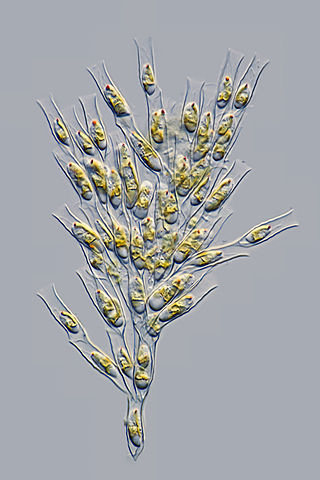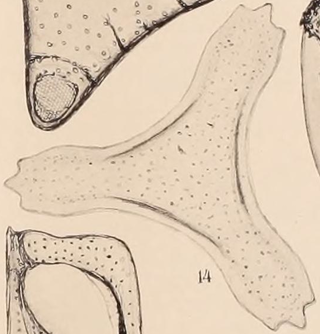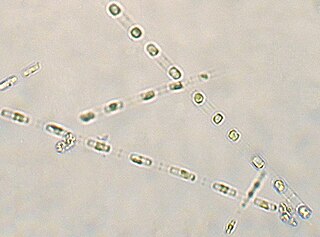Tertiarius is a genus of freshwater diatoms known from the fossil record.

Navicula is a genus of boat-shaped diatom algae, comprising over 1,200 species. Navicula is Latin for "small ship", and also a term in English for a boat-shaped incense-holder.

Bolidophyceae is a class of photosynthetic heterokont picophytoplankton, and consist of less than 20 known species. They are distinguished by the angle of flagellar insertion and swimming patterns as well as recent molecular analyses. Bolidophyceae is the sister taxon to the diatoms (Bacillariophyceae). They lack the characteristic theca of the diatoms, and have been proposed as an intermediate group between the diatoms and all other heterokonts.
Craticula is a genus of diatom that lies on or in the top layers of sediments in the freshwater to brackish water environments it inhabits. In addition to frustule morphology the genus differs from closely related species by its sexual reproduction and movement in response to light.
Stilus is a genus of diatoms in the family Plagiotropidaceae.
Acanthoceras may refer to:
Briggera is a genus of diatom known from the fossil record.
Hystrix is a genus of diatoms.

Dinobryon is a type of microscopic algae. It is one of the 22 genera in the family Dinobryaceae. Dinobryon are mixotrophs, capable of obtaining energy and carbon through photosynthesis and phagotrophy of bacteria. The genus comprises at least 37 described species. The best-known species are D. cylindricum and D. divergens, which come to the attention of humans annually due to transient blooms in the photic zone of temperate lakes and ponds. Such blooms may produce volatile organic compounds (VOCs) that produce odors and affect water quality.
Hyalodiscus is an extant genus of diatom known also from the fossil record.
Riedelia is a genus of diatoms known from the fossil record, comprising approximately eight species. Many of the species were originally described under the closely allied genus Hemiaulus. Paleontologists Hans-Joachim Schrader and Juliane Fenner, working with fossil specimens obtained from Leg 38 of the Deep Sea Drilling Program in the Norwegian and Greenland Seas, decided that several previous descriptions of diatoms belonging to Hemiaulus were rightfully placed on Riedelia. Schrader and Fenner note that while Hemiaulus diatoms have polygonal areolated valves, Riedelia valves are punctate with isolated punctae. Additionally, Riedelia typically have two spines, while Hemiaulus have only one. These characteristics were used to justify the placement of these species in Riedelia.

Oscillaria is a genus of filamentous diatoms.

Abas is an extinct genus of diatoms consisting of only one known species: Abas wittii. Originally observed as a fossil genus classified with diatom spore forms under the name Syringidium. Abas was observed to be live from the Eocene to Oligocene epoch appearing in tropical sites.

Trinacria is an extinct genus of diatoms present during the early Eocene, named for its triskelion shape.

Cerataulina is a diatom genus. Cerataulina is similar to another genus of the family Hemiaulaceae, Eucampia. Cerataulina inhabits coastlines and estuaries. Cerataulina was originally classified as Syringigium in 1980 by Hasle & Syvertsen.

Thalassiosira is a genus of centric diatoms, comprising over 100 marine and freshwater species. It is a diverse group of photosynthetic eukaryotes that make up a vital part of marine and freshwater ecosystems, in which they are key primary producers and essential for carbon cycling

Skeletonema is a genus of diatoms in the family Skeletonemataceae. It is the type genus of its family. The genus Skeletonema was established by R. K. Greville in 1865 for a single species, S. barbadense, found in the Barbados deposit [Jung 2009]. These diatoms are photosynthetic organisms, meaning they obtain carbon dioxide from their surrounding environment and produce oxygen along with other byproducts. Reproduce sexually and asexually [Guiry 2011]. Skeletonema belong to the morphological category referred to as centric diatoms. These are classified by having valves with radial symmetry and the cells lack significant motility [Horner 2002]. Skeletonema are cylindrical shaped with a silica frustule. Cells are joined by long marginal processes to form a filament [Horner 2002]. Their length ranges from 2-61 micrometers, with a diameter ranging from 2-21 micrometers [Hasle 1997]. They are found typically in the neritic zone of the ocean and are highly populous in coastal systems [Jung 2009]. The genus is considered cosmopolitan, showing a wide range of tolerance for salinity and temperature [Hasle 1973]. For example, they have been found in various aquatic environments such as brackish or freshwater. Skeletonema are found worldwide excluding Antarctic waters [Hevia-Orube 2016]. Some harmful effects these diatoms may have on an ecosystem are attributed to large blooming events which may cause hypoxic events in coastal systems. Additionally, they are known to cause water discoloration [Kraberg 2010].

Triparma is a genus of unicellular algae in the family Triparmaceae in the order Parmales. They form siliceous plates on the cell surface that aid in identification. Triparma is distinguished by its possession of three shield plates, three triradiate girdle plates, a triradiate girdle plate with notched ends, and a small ventral plate. It was first described by Booth & Marchant in 1987 and the holotype is Triparma columacea.

Actinoptychus is a genus of diatoms belonging to the family Heliopeltaceae.
Acanthocera is a genus of flies belonging to the family Tabanidae.










